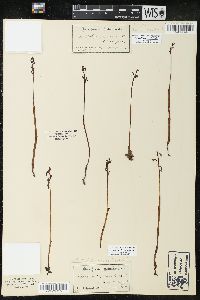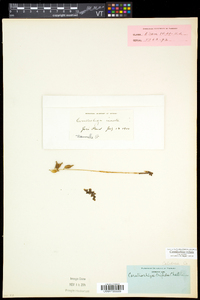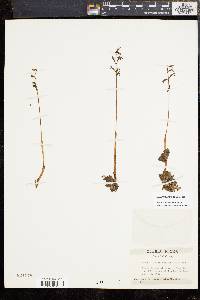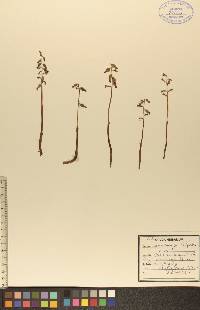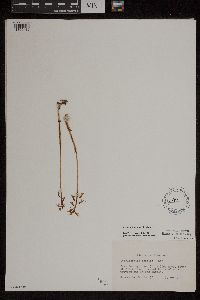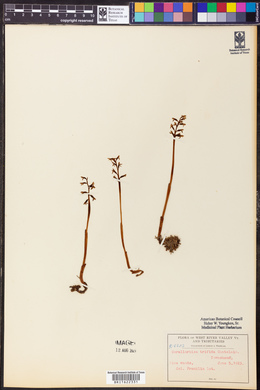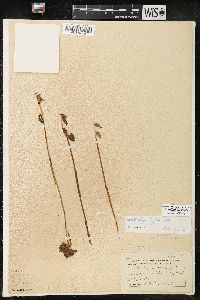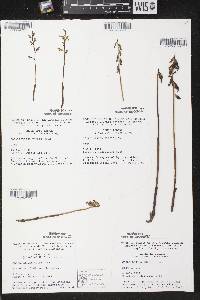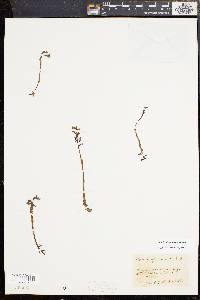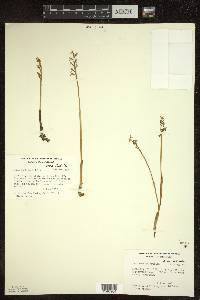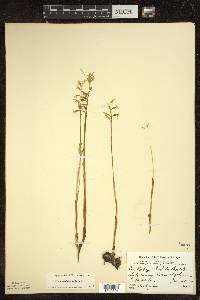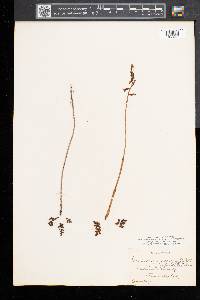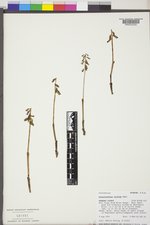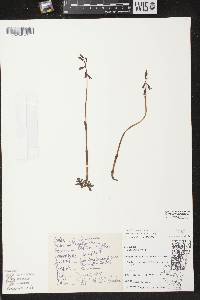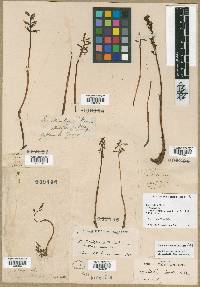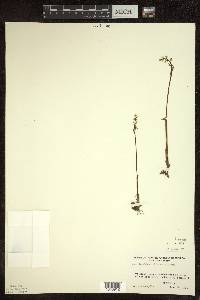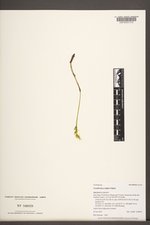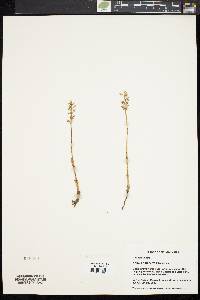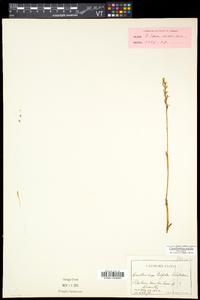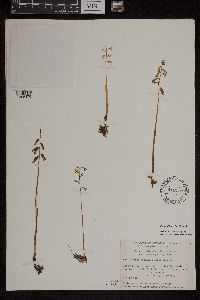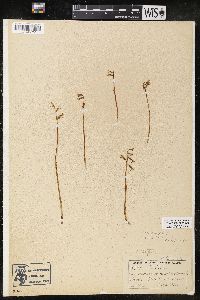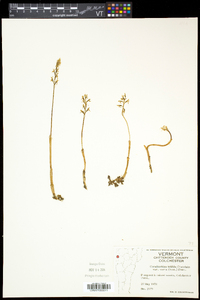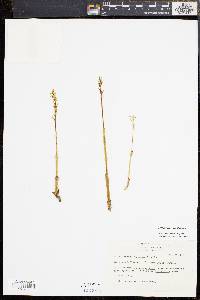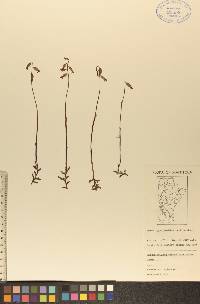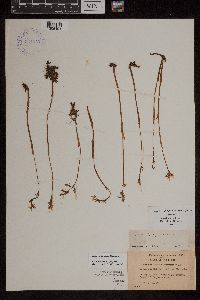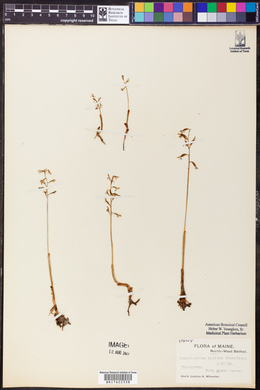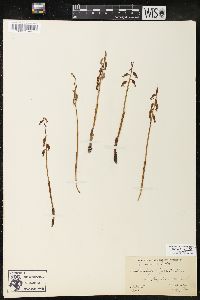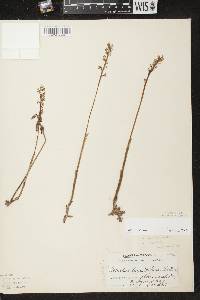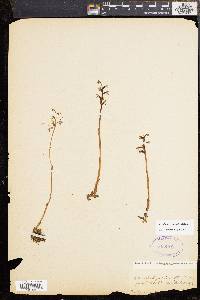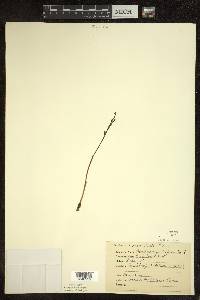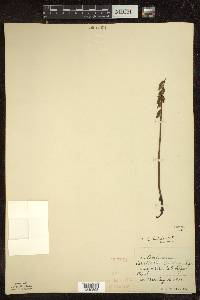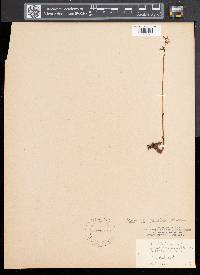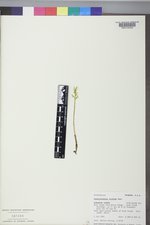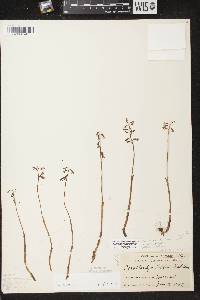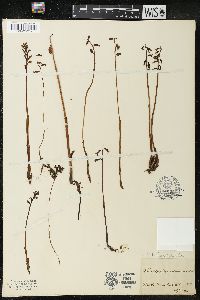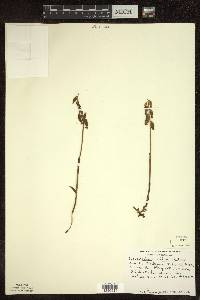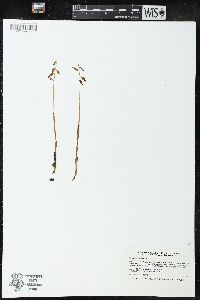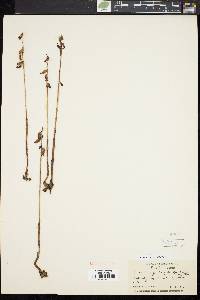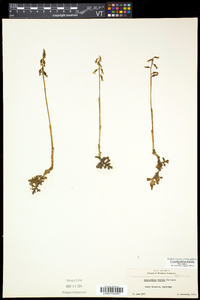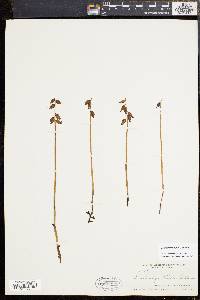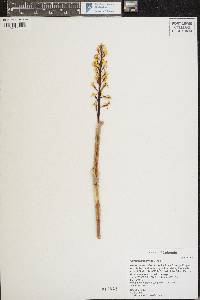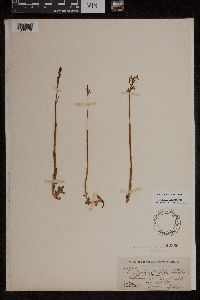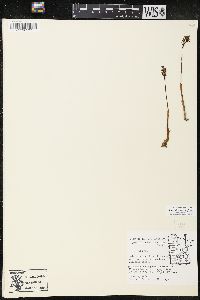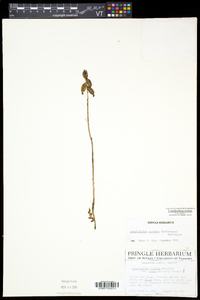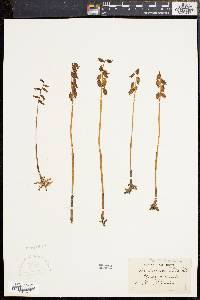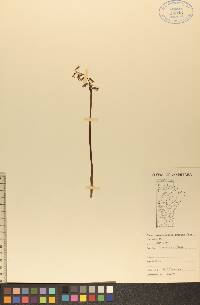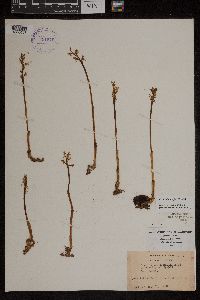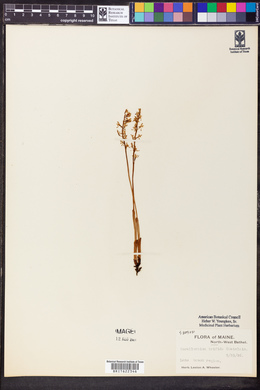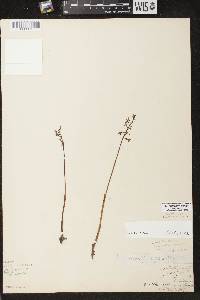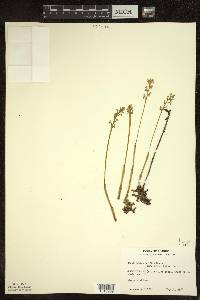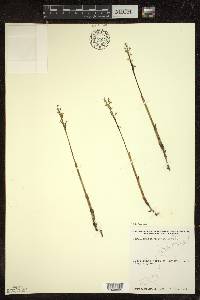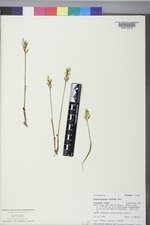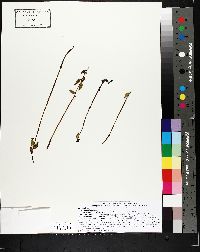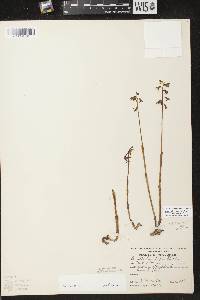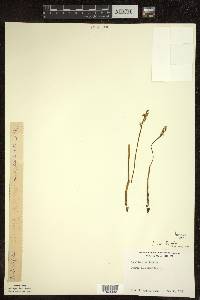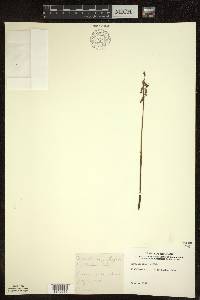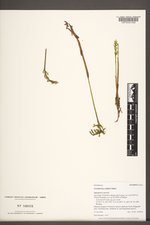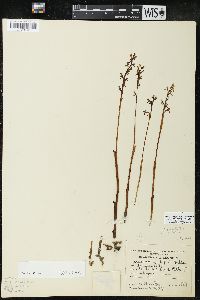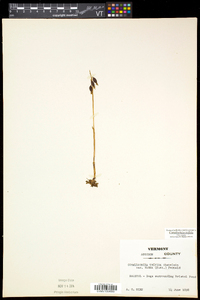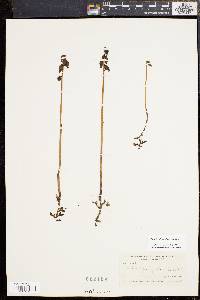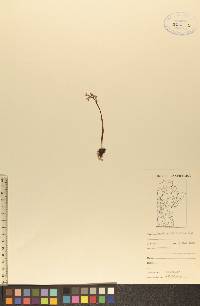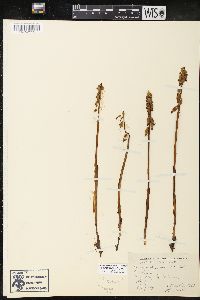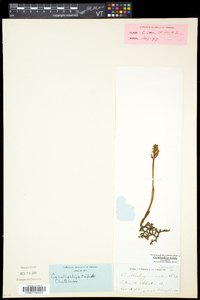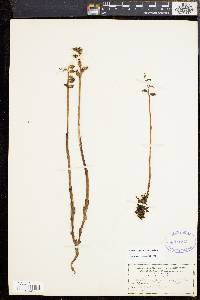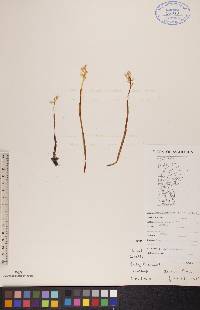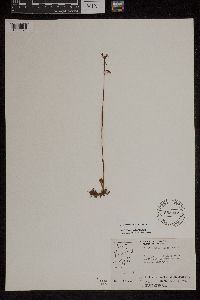Corallorhiza trifida
|
|
|
|
Family: Orchidaceae
Yellow Coralroot
[Corallorhiza corallorhiza MacMillan, moreCorallorhiza corallorhiza subsp. coloradensis Cockerell, not validly publ., Corallorhiza innata , Corallorhiza innata var. virescens (Drejer) Farr, Corallorhiza neottia Scop., Corallorhiza trifida var. verna (Nutt.) Fernald, Corallorhiza verna Nutt., Corallorhiza virescens Drejer, Corallorhiza wyomingensis , Corallorrhiza corallorrhiza Karst., Corallorrhiza trifida , Corallorrhiza trifida var. verna] |
Stems ± strongly thickened, base not bulbous. Inflorescences: racemes lax to dense, 8-35 × 1-3 cm. Flowers 3-18, inconspicuous; perianth open; sepals spreading, yellowish to green, lanceolate, 1-veined, 3.5-7 mm; lateral sepals often strongly recurved; petals arching over and clasping column, light yellow-green, often spotted with purple, lanceolate, 1-veined, 3-5.5 mm; lip white, often purple spotted, 2.5-4 × 1.5-3 mm, thin, with 2 small lateral lobes or teeth, middle lobe oblong, often somewhat dilated near apex, with 2 distinct basal lamellae; column curved toward lip, yellowish green, sometimes spotted purple basally, with shallow adaxial channel, 2-3.3 mm; ovary 2.1-6.5 mm; mentum inconspicuous. Capsules ellipsoid, 4.5-15 × 4.3-6 mm. 2n = 42. Flowering spring--summer. Coniferous, deciduous, and mixed woods, swamps, mountain woods, upland habitats northward, restricted to cool, moist habitats southward; 0--3100 m; Greenland; St. Pierre and Miquelon; Alta., B.C., Man., N.B., Nfld. and Labr., N.W.T., N.S., Nunavut, Ont., P.E.I., Que., Sask., Yukon; Alaska, Calif., Colo., Conn., Del., D.C., Idaho, Ill., Ind., Maine, Md., Mass., Mich., Minn., Mont., N.H., N.J., N.Mex., N.Y., N.Dak., Ohio, Oreg., Pa., R.I., S.Dak., Utah, Vt., Wash., W.Va., Wis., Wyo.; Eurasia. Corallorhiza trifida is largely autogamous, although a syrphid fly (Syrphus cinctellus) was reported as a pollinator by F. Silen (1906). Various floral morphs exist, some with weak geographic correlation; they do not appear to warrant taxonomic recognition. Variants of C. odontorhiza, C. wisteriana, and C. maculata without red and purple pigments in sepals and petals are occasionally misidentified as C. trifida.
Perennial mycotrophic (saprophytic) herb 5 - 25 cm tall Leaves: none. Inflorescence: a single, erect, terminal, stalked, loose, elongate (about 15 cm), spike-like cluster of three to fifteen, short-stalked, inconspicuous flowers with each flower subtended by a minute, 1 - 2 mm long, pointed bract. Flowers: yellowish white to pale yellow-green, under 1.5 cm wide, bilaterally symmetric, lateral sepals spreading, lateral petals and upper sepal converging to form a hood, and one petal formed into a lip, but lacking a spur. The reproductive parts of stamens, stigma and style are fused into a 2 - 3.3 mm long column above the 2.1 - 6.5 mm long inferior ovary. Column curved toward lip petal, yellowish green, sometimes spotted with purple at base, and with a shallow lengthwise channel on upper side. Sepals: three, petal-like, yellowish to green, 1 - 2 mm wide, inversely lance-shaped with one central vein. The lateral sepals are 3.5 - 7 mm long, tapered to pointed tips, and spreading somewhat downwards or sometimes recurved. Central sepal only 3 - 5 mm long, wider and blunt at tip, pointed upward but arching forward over column and closely positioned to lateral petals. Petals: three, upper two arching over column forming a hood with upper sepal, all with a single vein. The two lateral petals are light yellow-green, often spotted with purple, 3 - 5.5 mm long, 1 - 2 mm wide, and inversely lance-shaped. Lip white, 2.5 - 4 mm long, 1.5 - 3 mm wide, inversely egg-shaped to oblong in outline, but three-lobed with two small lateral, triangular lobes near base, and a much larger, oblong, central lobe. The middle lobe of the lip petal has two flattened lengthwise ridges (lamellae) on the surface below the middle, and it is often slightly expanded toward the tip and abruptly rounded at the minutely toothed apex. Fruit: several, short-stalked, drooping (at least when mature), bright greenish yellow, 0.5 - 1.5 cm long, 4.3 - 6 mm wide, ellipsoid to inversely egg-shaped capsules with three shallow lengthwise ribs. Flowering stem: single, stiffly erect, slender, slightly thickened at base, hairless, fleshy, pale yellow-green (becoming greener in fruit), lacking leaves, but with two to three tubular sheaths. This leafless structure terminated by flowers is called a scape and technically is not a true stem. Root system: lacking true roots, but with multiple-branched, coral-like rhizomes. Similar species: Corallorhiza trifida is unique from our other Chicago Region species since it does not have red and purple pigments in the sepals and petals. Otherwise it is most similar to C. maculata, but that species blooms later in the year (starts mid-July), the plant is typically taller (up to 60 cm), the sepals have three obvious veins, the lip petal is obviously spotted with purple, and it grows in more upland areas. Also flowering later in the year, C. odontorhiza can be distinguished since the flowers often do not open, the lateral sepals are close together and curve upwards, and the unlobed lip petal is white with purple spots. The only other spring flowering species in our area is C. wisteriana, but it is found in very discreet locations, has upward curved sepals, lacks lateral lobes on the lip, and there are purple spots on its lip. Flowering: May to early June Habitat and ecology: Extremely rare, possibly extirpated in the area, previously found in damp and swampy woods (especially those with tamarack or cedar), bogs, and low wet dune swale woods. Occurence in the Chicago region: native Notes: This species has a much more northern-distribution, with the Chicago Region being at the very southern end of the range. It has not been collected in Lake Co., IN since the 1890's, though it was reported in the late 1920's and 1930 in Porter County, IN at Dune Park, which is now destroyed and has been replaced by an industrial development. This is an unusual species of Corallorhiza since it has chlorophyll (evidenced by green coloring). Presumably this means the plant has at least some ability to photosynthesize, but it is still primarily a mycotroph with fungal mycorrhizae in the rhizome connecting to roots of cedar, tamarack, or spruce trees (Campbell 1970). This species is reported to mostly reproduce by self-pollination, but some have reported a syrphid fly (Syrphus cinctellus) as a pollinator (see Magrath and Freudenstein 2002). Etymology: Corallorhiza comes from the Greek words korallion, meaning coral, and rhiza, meaning root, in reference to the branching, underground rhizome, which has a similar appearance to coral. Trifida means cleft or parted into three, which refers to the three-lobed lip petal of the flower. Author: The Field Museum Stem 1-3 dm, yellowish to greenish; infl 2-8 cm; fls 5-15; sep and lateral pet yellowish-green, to light purplish, lanceolate, 4-5 mm, 1-nerved (or the pet weakly 3-nerved), the lateral sep extending forward under or alongside the lip; spur none; lip 3.5-5 mm, white, sometimes purple-spotted, with 2 short lateral lobes below the middle and 2 short parallel ridges on the face, the terminal lobe truncate and deflexed, 1.5-2 mm wide; 2n=42. Wet woods; circumboreal, s. in Amer. to N.J., Pa., Ill., Mo., and N.M. May-July. (C. corallorhiza) The more southern phase of the sp. (and the common form in our range), with unspotted lip, has been segregated as var. verna (Nutt.) Fernald from the more northern and circumboreal form with spotted lip. Gleason, Henry A. & Cronquist, Arthur J. 1991. Manual of vascular plants of northeastern United States and adjacent Canada. lxxv + 910 pp. ©The New York Botanical Garden. All rights reserved. Used by permission. From Flora of Indiana (1940) by Charles C. Deam This species is admitted to our flora upon the authority of Pepoon, who says: "Frequent in the dune swale woods northeast of Dune Park" (Porter County), and upon the basis of a specimen collected by Umbach in 1892 at Miller (Lake County), now in the herbarium of the University of Wisconsin. It was also reported from Floyd County but that record should, no doubt, be referred to some other species. |


